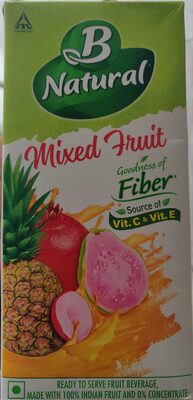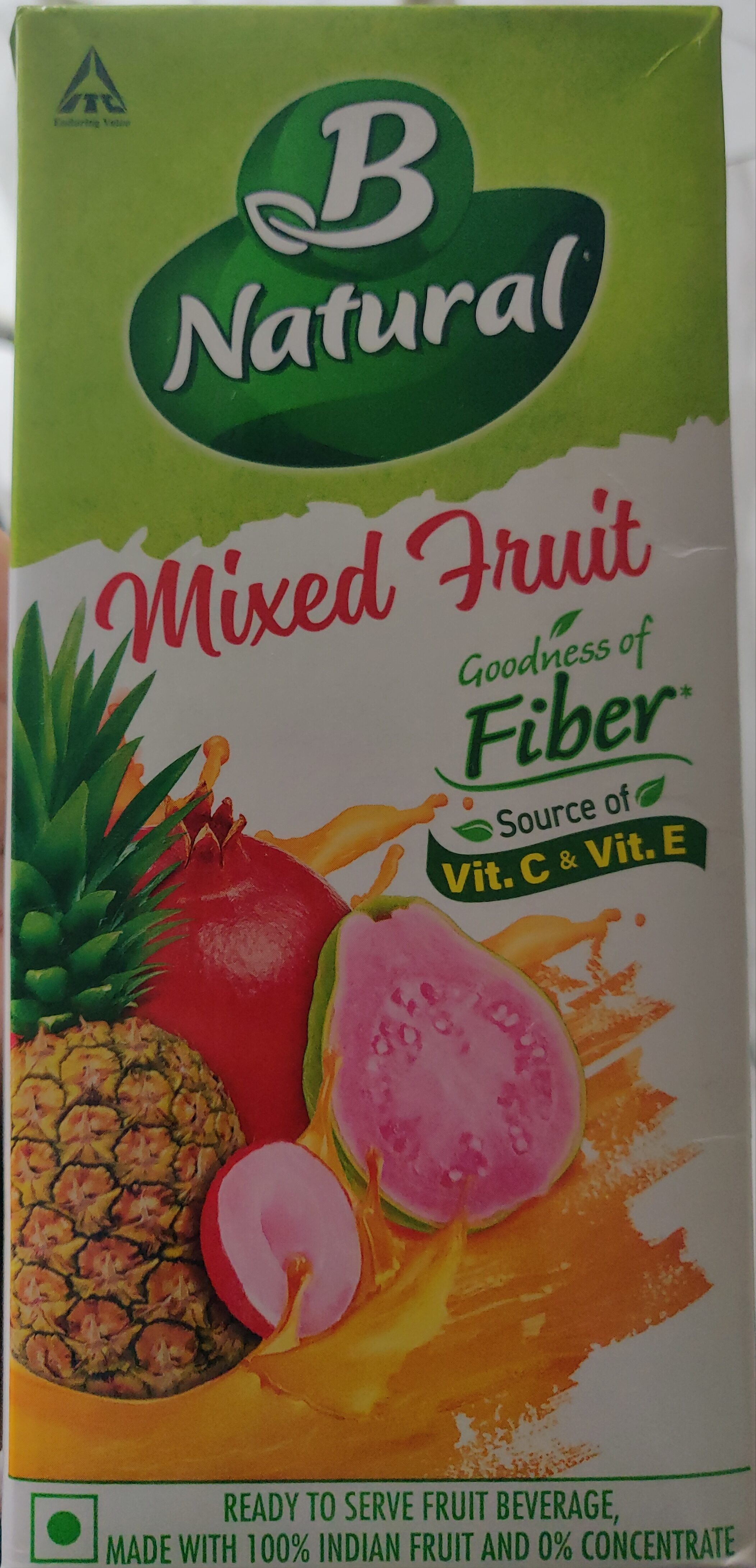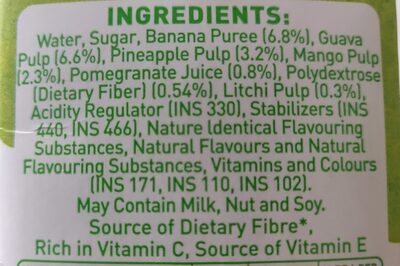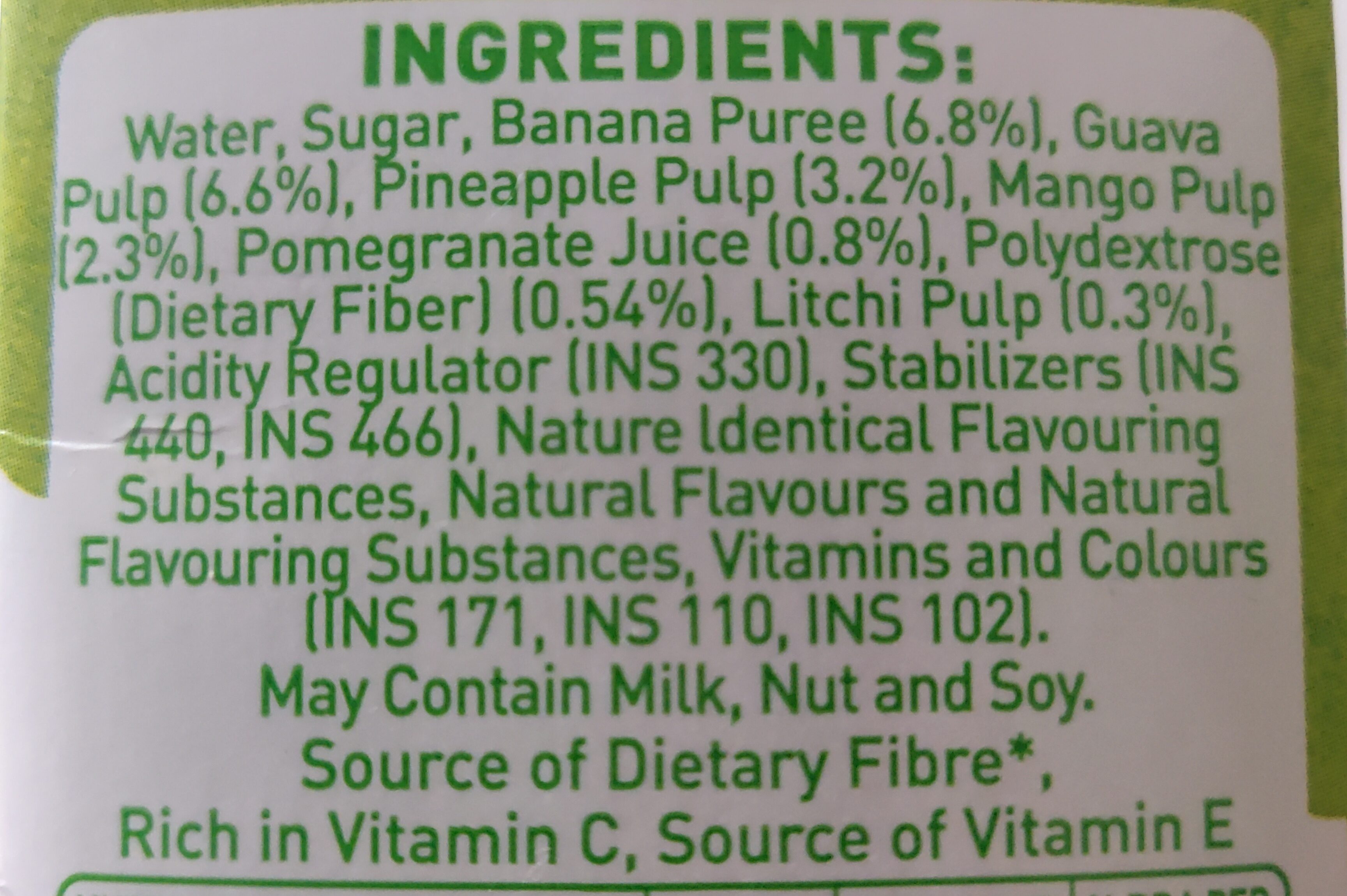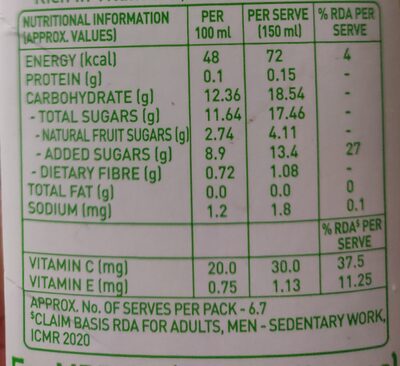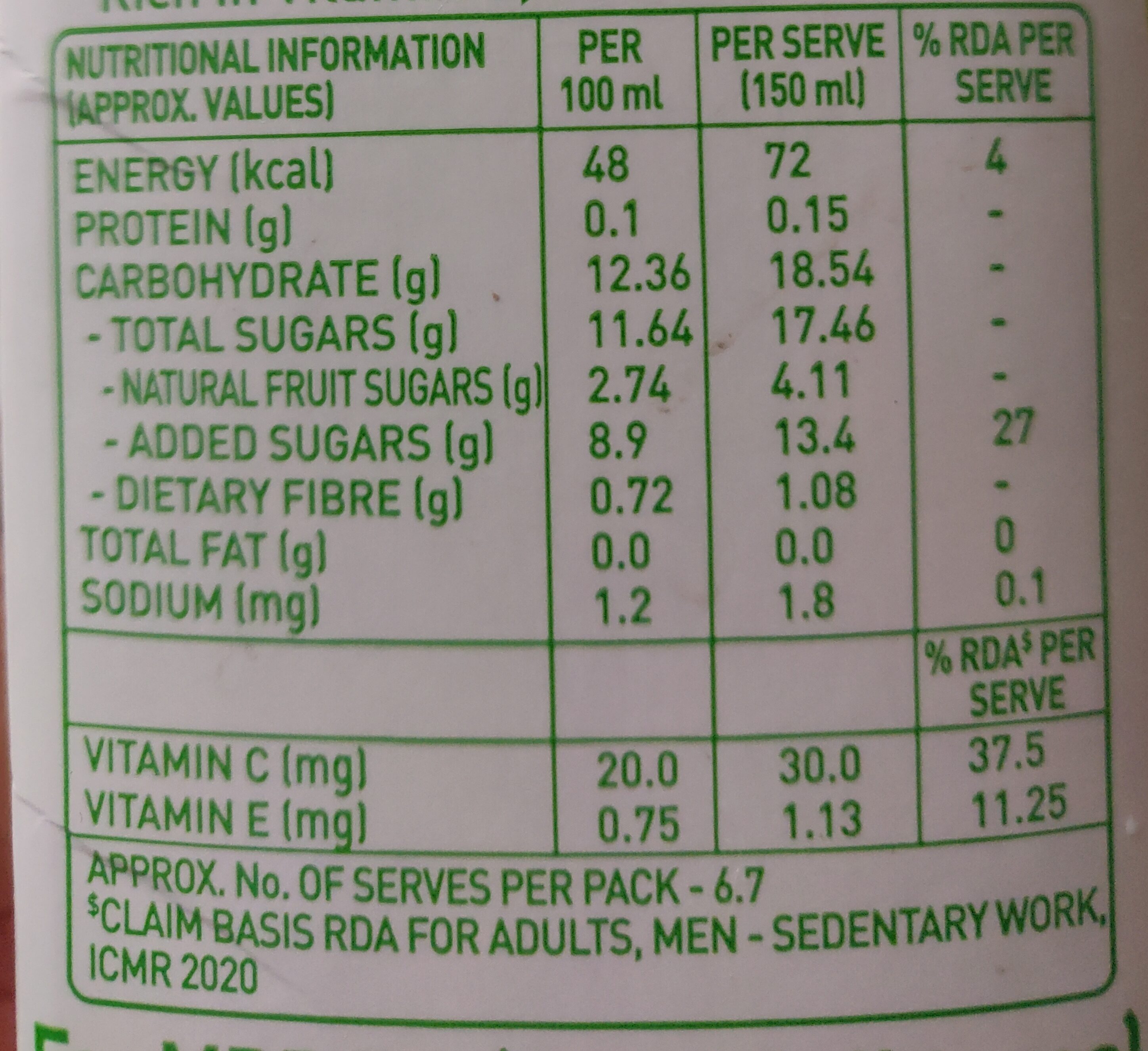Help us make food transparency the norm!
As a non-profit organization, we depend on your donations to continue informing consumers around the world about what they eat.
The food revolution starts with you!
B Natural Mixed fruit - ITC Limied - 12
B Natural Mixed fruit - ITC Limied - 12
This product page is not complete. You can help to complete it by editing it and adding more data from the photos we have, or by taking more photos using the app for Android or iPhone/iPad. Thank you!
×
Barcode: 8901725100025 (EAN / EAN-13)
Quantity: 12
Brands: ITC Limied
Categories: Plant-based foods and beverages, Beverages, Plant-based beverages, Fruit-based beverages, Juices and nectars, Fruit juices
Labels, certifications, awards: Rich in vitamin C, Vitamin E source
Origin of ingredients: Indian fruit
Link to the product page on the official site of the producer: http://itc.in
Countries where sold: India
Matching with your preferences
Health
Ingredients
-
24 ingredients
Water, Sugar, Banana Puree (6.8%), Guava Pulp (6.6%), Pineapple Pulp (3.2%), Mango Pulp (2.3%), Pomegranate Juice (0.8%), Polydextrose (Dietary Fiber) (0.54%), Litchi Pulp (0.3%), Acidity Regulator (INS 330), Stabilizers (INS 440, INS 466), Nature Identical Flavouring Substances, Natural Flavours and Natural Flavouring Substances, Vitamins and Colours (INS 171, INS 110, INS 102). May Contain Milk, Nut and Soy. Source of Dietary Fibre*, Rich in Vitamin C, Source of Vitamin ETraces: Milk, Nuts, Soybeans
Food processing
-
Ultra processed foods
Elements that indicate the product is in the 4 - Ultra processed food and drink products group:
- Additive: E102 - Tartrazine
- Additive: E110 - Sunset yellow FCF
- Additive: E171 - Titanium dioxide
- Additive: E440 - Pectins
- Additive: E466 - Sodium carboxy methyl cellulose
- Ingredient: Colour
- Ingredient: Flavouring
Food products are classified into 4 groups according to their degree of processing:
- Unprocessed or minimally processed foods
- Processed culinary ingredients
- Processed foods
- Ultra processed foods
The determination of the group is based on the category of the product and on the ingredients it contains.
Additives
-
E102 - Tartrazine
Tartrazine: Tartrazine is a synthetic lemon yellow azo dye primarily used as a food coloring. It is also known as E number E102, C.I. 19140, FD&C Yellow 5, Acid Yellow 23, Food Yellow 4, and trisodium 1--4-sulfonatophenyl--4--4-sulfonatophenylazo--5-pyrazolone-3-carboxylate-.Tartrazine is a commonly used color all over the world, mainly for yellow, and can also be used with Brilliant Blue FCF -FD&C Blue 1, E133- or Green S -E142- to produce various green shades.Source: Wikipedia
-
E110 - Sunset yellow FCF
Sunset Yellow FCF: Sunset Yellow FCF -also known as Orange Yellow S, or C.I. 15985- is a petroleum-derived orange azo dye with a pH dependent maximum absorption at about 480 nm at pH 1 and 443 nm at pH 13 with a shoulder at 500 nm. When added to foods sold in the US it is known as FD&C Yellow 6; when sold in Europe, it is denoted by E Number E110.Source: Wikipedia
-
E1200 - Polydextrose
Polydextrose: Polydextrose is a synthetic polymer of glucose. It is a food ingredient classified as soluble fiber by the U.S. Food and Drug Administration -FDA- as well as Health Canada, as of April 2013. It is frequently used to increase the dietary fiber content of food, to replace sugar, and to reduce calories and fat content. It is a multi-purpose food ingredient synthesized from dextrose -glucose-, plus about 10 percent sorbitol and 1 percent citric acid. Its E number is E1200. The FDA approved it in 1981. It is 0.1 times as sweet as sugar.Source: Wikipedia
-
E171 - Titanium dioxide
Titanium dioxide: Titanium dioxide, also known as titaniumIV oxide or titania, is the naturally occurring oxide of titanium, chemical formula TiO2. When used as a pigment, it is called titanium white, Pigment White 6 -PW6-, or CI 77891. Generally, it is sourced from ilmenite, rutile and anatase. It has a wide range of applications, including paint, sunscreen and food coloring. When used as a food coloring, it has E number E171. World production in 2014 exceeded 9 million metric tons. It has been estimated that titanium dioxide is used in two-thirds of all pigments, and the oxide has been valued at $13.2 billion.Source: Wikipedia
-
E330 - Citric acid
Citric acid is a natural organic acid found in citrus fruits such as lemons, oranges, and limes.
It is widely used in the food industry as a flavor enhancer, acidulant, and preservative due to its tart and refreshing taste.
Citric acid is safe for consumption when used in moderation and is considered a generally recognized as safe (GRAS) food additive by regulatory agencies worldwide.
-
E440 - Pectins
Pectins (E440) are natural carbohydrates, predominantly found in fruits, that act as gelling agents in the food industry, creating the desirable jelly-like texture in jams, jellies, and marmalades.
Pectins stabilize and thicken various food products, such as desserts, confectioneries, and beverages, ensuring a uniform consistency and quality.
Recognized as safe by various health authorities, pectins have been widely used without notable adverse effects when consumed in typical dietary amounts.
-
E466 - Sodium carboxy methyl cellulose
Carboxymethyl cellulose: Carboxymethyl cellulose -CMC- or cellulose gum or tylose powder is a cellulose derivative with carboxymethyl groups --CH2-COOH- bound to some of the hydroxyl groups of the glucopyranose monomers that make up the cellulose backbone. It is often used as its sodium salt, sodium carboxymethyl cellulose.Source: Wikipedia
Ingredients analysis
-
Palm oil free
No ingredients containing palm oil detected
Unrecognized ingredients: Dietary-fiber, Source-of-dietary-fibreSome ingredients could not be recognized.
We need your help!
You can help us recognize more ingredients and better analyze the list of ingredients for this product and others:
- Edit this product page to correct spelling mistakes in the ingredients list, and/or to remove ingredients in other languages and sentences that are not related to the ingredients.
- Add new entries, synonyms or translations to our multilingual lists of ingredients, ingredient processing methods, and labels.
If you would like to help, join the #ingredients channel on our Slack discussion space and/or learn about ingredients analysis on our wiki. Thank you!
-
Vegan status unknown
Unrecognized ingredients: Dietary-fiber, Source-of-dietary-fibreSome ingredients could not be recognized.
We need your help!
You can help us recognize more ingredients and better analyze the list of ingredients for this product and others:
- Edit this product page to correct spelling mistakes in the ingredients list, and/or to remove ingredients in other languages and sentences that are not related to the ingredients.
- Add new entries, synonyms or translations to our multilingual lists of ingredients, ingredient processing methods, and labels.
If you would like to help, join the #ingredients channel on our Slack discussion space and/or learn about ingredients analysis on our wiki. Thank you!
-
Vegetarian status unknown
Unrecognized ingredients: Dietary-fiber, Source-of-dietary-fibreSome ingredients could not be recognized.
We need your help!
You can help us recognize more ingredients and better analyze the list of ingredients for this product and others:
- Edit this product page to correct spelling mistakes in the ingredients list, and/or to remove ingredients in other languages and sentences that are not related to the ingredients.
- Add new entries, synonyms or translations to our multilingual lists of ingredients, ingredient processing methods, and labels.
If you would like to help, join the #ingredients channel on our Slack discussion space and/or learn about ingredients analysis on our wiki. Thank you!
-
Details of the analysis of the ingredients
We need your help!
Some ingredients could not be recognized.
We need your help!
You can help us recognize more ingredients and better analyze the list of ingredients for this product and others:
- Edit this product page to correct spelling mistakes in the ingredients list, and/or to remove ingredients in other languages and sentences that are not related to the ingredients.
- Add new entries, synonyms or translations to our multilingual lists of ingredients, ingredient processing methods, and labels.
If you would like to help, join the #ingredients channel on our Slack discussion space and/or learn about ingredients analysis on our wiki. Thank you!
en: Water, Sugar, Banana 6.8%, Guava 6.6%, Pineapple 3.2%, Mango 2.3%, Pomegranate Juice 0.8%, Polydextrose (Dietary Fiber), Litchi Pulp 0.3%, Acidity Regulator (e330), Stabilizers (e440, e466), Nature Identical Flavouring Substances, Natural Flavours, Natural Flavouring Substances, Vitamins, Colours (e171, e110, e102), Source of Dietary Fibre- Water -> en:water - vegan: yes - vegetarian: yes - ciqual_food_code: 18066 - percent_min: 65.2 - percent_max: 72.9
- Sugar -> en:sugar - vegan: yes - vegetarian: yes - ciqual_proxy_food_code: 31016 - percent_min: 6.8 - percent_max: 11.6
- Banana -> en:banana - vegan: yes - vegetarian: yes - ciqual_food_code: 13005 - percent_min: 6.8 - percent: 6.8 - percent_max: 6.8
- Guava -> en:guava - vegan: yes - vegetarian: yes - percent_min: 6.6 - percent: 6.6 - percent_max: 6.6
- Pineapple -> en:pineapple - vegan: yes - vegetarian: yes - percent_min: 3.2 - percent: 3.2 - percent_max: 3.2
- Mango -> en:mango - vegan: yes - vegetarian: yes - ciqual_food_code: 13025 - percent_min: 2.3 - percent: 2.3 - percent_max: 2.3
- Pomegranate Juice -> en:pomegranate-juice - vegan: yes - vegetarian: yes - percent_min: 0.8 - percent: 0.8 - percent_max: 0.8
- Polydextrose -> en:e1200 - vegan: yes - vegetarian: yes - percent_min: 0.3 - percent_max: 0.8
- Dietary Fiber -> en:dietary-fiber - percent_min: 0.3 - percent_max: 0.8
- Litchi Pulp -> en:lychee-pulp - vegan: yes - vegetarian: yes - ciqual_food_code: 13023 - percent_min: 0.3 - percent: 0.3 - percent_max: 0.3
- Acidity Regulator -> en:acidity-regulator - percent_min: 0 - percent_max: 0.3
- e330 -> en:e330 - vegan: yes - vegetarian: yes - percent_min: 0 - percent_max: 0.3
- Stabilizers -> en:stabiliser - percent_min: 0 - percent_max: 0.3
- e440 -> en:e440a - vegan: yes - vegetarian: yes - percent_min: 0 - percent_max: 0.3
- e466 -> en:e466 - vegan: yes - vegetarian: yes - percent_min: 0 - percent_max: 0.15
- Nature Identical Flavouring Substances -> en:nature-identical-flavouring - vegan: maybe - vegetarian: maybe - percent_min: 0 - percent_max: 0.3
- Natural Flavours -> en:natural-flavouring - vegan: maybe - vegetarian: maybe - percent_min: 0 - percent_max: 0.3
- Natural Flavouring Substances -> en:natural-flavouring - vegan: maybe - vegetarian: maybe - percent_min: 0 - percent_max: 0.3
- Vitamins -> en:vitamins - vegan: yes - vegetarian: yes - percent_min: 0 - percent_max: 0.3
- Colours -> en:colour - percent_min: 0 - percent_max: 0.3
- e171 -> en:e171 - vegan: yes - vegetarian: yes - percent_min: 0 - percent_max: 0.3
- e110 -> en:e110 - vegan: yes - vegetarian: yes - percent_min: 0 - percent_max: 0.15
- e102 -> en:e102 - vegan: yes - vegetarian: yes - percent_min: 0 - percent_max: 0.1
- Source of Dietary Fibre -> en:source-of-dietary-fibre - percent_min: 0 - percent_max: 0.3
Nutrition
-
Bad nutritional quality
⚠ ️Warning: the amount of fruits, vegetables and nuts is not specified on the label, it was estimated from the list of ingredients: 20This product is considered a beverage for the calculation of the Nutri-Score.
Positive points: 0
- Proteins: 0 / 5 (value: 0.1, rounded value: 0.1)
- Fiber: 0 / 5 (value: 0.72, rounded value: 0.72)
- Fruits, vegetables, nuts, and colza/walnut/olive oils: 0 / 10 (value: 20, rounded value: 20)
Negative points: 15
- Energy: 7 / 10 (value: 201, rounded value: 201)
- Sugars: 8 / 10 (value: 11.6, rounded value: 11.6)
- Saturated fat: 0 / 10 (value: 0, rounded value: 0)
- Sodium: 0 / 10 (value: 1.2, rounded value: 1.2)
The points for proteins are not counted because the negative points are greater or equal to 11.
Nutritional score: (15 - 0)
Nutri-Score:
-
Nutrient levels
-
Fat in low quantity (0%)
What you need to know- A high consumption of fat, especially saturated fats, can raise cholesterol, which increases the risk of heart diseases.
Recommendation: Limit the consumption of fat and saturated fat- Choose products with lower fat and saturated fat content.
-
Sugars in high quantity (11.6%)
What you need to know- A high consumption of sugar can cause weight gain and tooth decay. It also augments the risk of type 2 diabetes and cardio-vascular diseases.
Recommendation: Limit the consumption of sugar and sugary drinks- Sugary drinks (such as sodas, fruit beverages, and fruit juices and nectars) should be limited as much as possible (no more than 1 glass a day).
- Choose products with lower sugar content and reduce the consumption of products with added sugars.
-
Salt in low quantity (0.003%)
What you need to know- A high consumption of salt (or sodium) can cause raised blood pressure, which can increase the risk of heart disease and stroke.
- Many people who have high blood pressure do not know it, as there are often no symptoms.
- Most people consume too much salt (on average 9 to 12 grams per day), around twice the recommended maximum level of intake.
Recommendation: Limit the consumption of salt and salted food- Reduce the quantity of salt used when cooking, and don't salt again at the table.
- Limit the consumption of salty snacks and choose products with lower salt content.
-
-
Nutrition facts
Nutrition facts As sold
for 100 g / 100 mlAs sold
per serving (150ml)Compared to: Fruit juices Energy 201 kj
(48 kcal)301 kj
(72 kcal)+6% Fat 0 g 0 g -100% Saturated fat ? ? Carbohydrates 12.4 g 18.54 g +19% Sugars 11.6 g 17.46 g +20% Fiber 0.72 g 1.08 g +140% Proteins 0.1 g 0.15 g -72% Salt 0.003 g 0.004 g -68% Fruits‚ vegetables‚ nuts and rapeseed‚ walnut and olive oils (estimate from ingredients list analysis) 20 % 20 %
Environment
-
Eco-Score D - High environmental impact
⚠ ️Select a country in order to include the full impact of transportation.The Eco-Score is an experimental score that summarizes the environmental impacts of food products.→ The Eco-Score was initially developped for France and it is being extended to other European countries. The Eco-Score formula is subject to change as it is regularly improved to make it more precise and better suited to each country.Life cycle analysis
-
Average impact of products of the same category: C (Score: 41/100)
Category: Mixed fruits juice, pure juice
Category: Mixed fruits juice, pure juice
- PEF environmental score: 0.19 (the lower the score, the lower the impact)
- including impact on climate change: 0.83 kg CO2 eq/kg of product
Stage Impact Agriculture
68.9 %Processing
2.9 %Packaging
7.3 %Transportation
15.1 %Distribution
4.6 %Consumption
1.3 %
Bonuses and maluses
-
Missing origins of ingredients information
Malus: -5
⚠ ️ The origins of the ingredients of this product are not indicated.
If they are indicated on the packaging, you can modify the product sheet and add them.
If you are the manufacturer of this product, you can send us the information with our free platform for producers.
-
Missing packaging information for this product
Malus: -15
⚠ ️ The information about the packaging of this product is not filled in.⚠ ️ For a more precise calculation of the Eco-Score, you can modify the product page and add them.
If you are the manufacturer of this product, you can send us the information with our free platform for producers.
Eco-Score for this product
-
Impact for this product: D (Score: 21/100)
Product: B Natural Mixed fruit - ITC Limied - 12
Life cycle analysis score: 41
Sum of bonuses and maluses: -20
Final score: 21/100
-
Carbon footprint
-
Equal to driving 0.4 km in a petrol car
83 g CO² per 100g of product
The carbon emission figure comes from ADEME's Agribalyse database, for the category: Mixed fruits juice, pure juice (Source: ADEME Agribalyse Database)
Stage Impact Agriculture
28.0 %Processing
10.6 %Packaging
17.8 %Transportation
38.5 %Distribution
4.3 %Consumption
0.8 %
Packaging
-
Missing packaging information for this product
⚠ ️ The information about the packaging of this product is not filled in.Take a photo of the recycling information Take a photo of the recycling information
Transportation
-
Origins of ingredients
Missing origins of ingredients information
⚠ ️ The origins of the ingredients of this product are not indicated.
If they are indicated on the packaging, you can modify the product sheet and add them.
If you are the manufacturer of this product, you can send us the information with our free platform for producers.Add the origins of ingredients for this product Add the origins of ingredients for this product
Report a problem
-
Incomplete or incorrect information?
Category, labels, ingredients, allergens, nutritional information, photos etc.
If the information does not match the information on the packaging, please complete or correct it. Open Food Facts is a collaborative database, and every contribution is useful for all.
Data sources
Product added on by foodless
Last edit of product page on by foodless.
Product page also edited by ranjithsiji.
